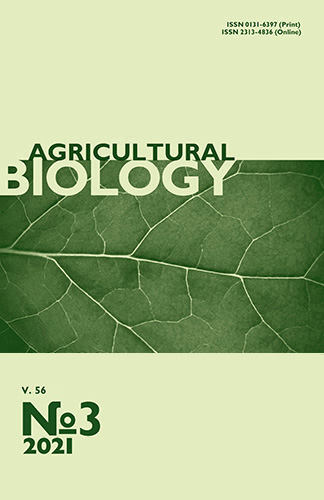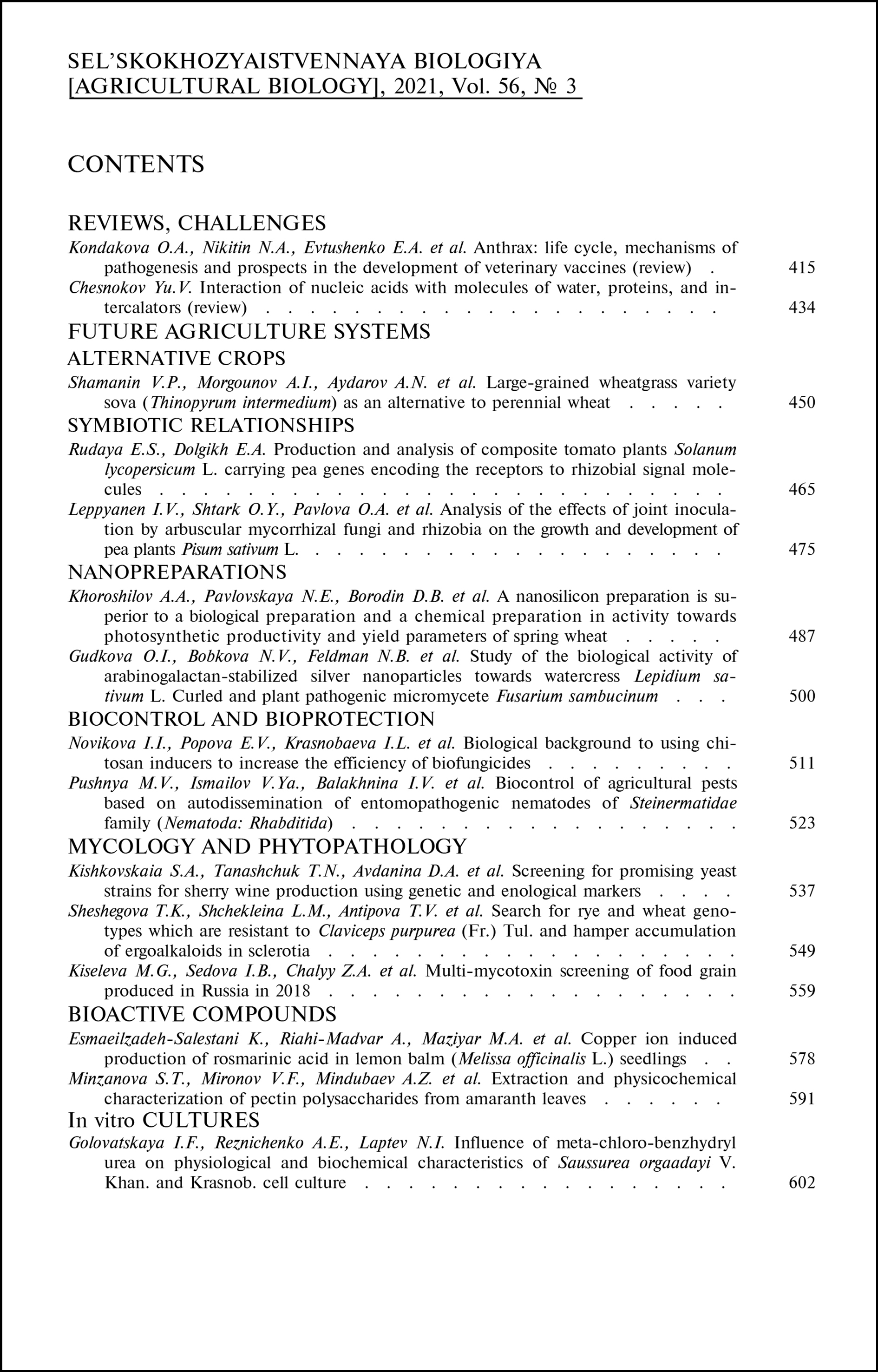doi: 10.15389/agrobiology.2021.3.475eng
UDC: 635.656:579.64:631.811
Acknowledgements:
Supported financially by the Russian Science Foundation (grant No. 17-76-30016)
ANALYSIS OF THE EFFECTS OF JOINT INOCULATION BY ARBUSCULAR MYCORRHIZAL FUNGI AND RHIZOBIA ON THE GROWTH AND DEVELOPMENT OF PEA PLANTS Pisum sativum L.
I.V. Leppyanen, O.Y. Shtark, O.A. Pavlova, A.D. Bovin, K.A. Ivanova, T.S. Serova, E.A. Dolgikh ✉
All-Russian Research Institute for Agricultural Microbiology, Federal Agency for Scientific Organizations, 3, sh. Podbel’skogo, St. Petersburg, 196608 Russia, e-mailirina_leppyanen@mail.ru, oshtark@yandex.ru, dobbi85@list.ru, andy-piter2007@mail.ru, kivanova@arriam.ru, t_serova@rambler.ru, dol2helen@yahoo.com (corresponding author ✉)
ORCID:
Leppyanen I.V. orcid.org/0000-0002-2158-0855
Ivanova K.A. orcid.org/0000-0003-4915-4126
Shtark O.Y. orcid.org/0000-0002-3656-4559
Serova T.S. orcid.org/0000-0003-4784-1675
Pavlova O.A. orcid.org/0000-0003-0528-5618
Dolgikh E.A. orcid.org/0000-0002-5375-0943
Bovin A.D. orcid.org/0000-0003-4061-435X
Received November 18, 2020
Co-inoculation of plants with arbuscular mycorrhizal (AM) fungi and nitrogen-fixing bacteria of the order Rhizobiales (rhizobia) can have a stimulating effect on plant growth and development. This influence can be considered as the synergistic effect of two microorganisms on a plant in a multicomponent system and as the result of the mutual influence of microorganisms on each other. However, the mechanisms underlying the mutual influence of microorganisms remain insufficiently understood. In the presented work, it was shown for the first time that in the case of joint inoculation of pea plants with fungi of arbuscular mycorrhiza and rhizobia, the method of introduction microorganisms may be important. The results may indicate the presence of competition of microorganisms for a niche in the plant during sequential inoculation. The purpose of our research was to study the possibility of selection of the effective combinations of AM and rhizobia strains for inoculation of such important agricultural crop as Pisum sativum L. as well as estimation of influence on the productivity of plants. In this work, we analyzed the effects of joint inoculation of pea plants Pisum sativum L. with the fungus Rhizophagus irregularis BEG144 and the rhizobial strain R. leguminosarum bv. viciae RCAM 1026. For this purpose, the level of induction of markers development of two types of symbiosis, the degree of root mycorrhization were assessed, as well as the biometric parameters of plants. The research was performed using pea seedlings of the cultivar Frisson grown under sterile conditions. The isolate of the fungus Rhizophagus irregularis BEG144 was used for inoculation. An inoculum was obtained from the mycorrhized roots of Plecthrantus australis. The inoculum was introduced into a moisture substrate before planting the pea seedlings. The scheme of sequential inoculation was used, according to which pea plants were first inoculated with AM fungi R. irregularis BEG144 and 7 days after cultivation, the rhizobial strain Rhizobium leguminosarum bv. viciae RCAM 1026 were introduced into the system. The experimental scheme included the following options: without inoculation (control), R. leguminosarum (Rlv), R. irregularis (AM), R. irregularis + R. leguminosarum (AM + Rlv). 9 and 21 days after planting (2 and 14 days after bacterial inoculation), the material was collected to analyze the expression of genes - markers of the legume-rhizobial symbiosis development. On day 21 after planting, the plants were collected in order to determine their biometric parameters, as well as the markers of the symbiosis development. The lateral roots of the plants were cut off and frozen in liquid nitrogen. After isolation of the total RNA, cDNA was synthesized on the RNA template using reverse transcriptase using oligo(dT) primers. For the analysis, quantitative PCR combined with reverse transcription (RT-PCR) was performed (a CFX96 Real-Time instrument, «Bio-Rad Laboratories», USA). The total weight of plants and the weight of the root system significantly increased in case of monoinoculation with rhizobia, monoinoculation with AM fungi, as well as joint inoculation, compared with the control variant. However, no significant differences in these biometric parameters between the variant with monoinoculation with rhizobia or AM fungi and double inoculation were found. Probably, upon inoculation with several endosymbionts, competition arose between them at the stage of penetration into the plant, which led to a decrease in the intensity of plant infection with rhizobia. This was evidenced by the absence of additional stimulation of the Enod5 and Sym37 gene expression during double inoculation, which are activated in the plant during the development of rhizobial infection. Upon double inoculation, we also did not reveal additional stimulation of the expression of marker genes of symbiosis with AM fungi — PT4, TI, RAM1 and DELLA3. This correlated with the absence of significant differences in all biometric parameters between the variant with monoinoculation with rhizobia or AM fungi and double inoculation, which does not allow us to conclude about the positive effect of double inoculation on the growth and development of pea plants under the conditions of this experiment. The results of data analysis using the experimental scheme used may indicate the presence of competition of microorganisms for a niche in the plant, leading to a decrease in intra-root mycorrhizal colonization and the level of induction of markers that are activated during the development of rhizobial infection.
Keywords: plant-microbe interactions, rhizosphere, symbiosis, arbuscular mycorrhiza, inoculation, rhizobia, Rhizophagus irregularis, gene expression, Pisum sativum.
REFERENCES
- Lal R. Soils and sustainable agriculture: a review. In: Sustainable agriculture. E. Lichtfouse, M. Navarrete, P. Debaeke, S. Veronique, C. Alberola (eds.). Springer, 2009: 15-23 CrossRef
- Conway G.R., Barbier E.B. After the green revolution: sustainable agriculture for development. Routledge, London, 2013 CrossRef
- Mahanty T., Bhattacharjee S., Goswami M., Bhattacharyya P., Das B., Ghosh A., Tribedi P. Biofertilizers: a potential approach for sustainable agriculture development. Environmental Science and Pollution Research International, 2017, 24(4): 3315-3335 CrossRef
- Bethlenfalvay G.J., Brown M.S., Franson R.L. Glycine-Glomus-Bradyrhizobium symbiosis: X. Relationships between leaf gas exchange and plant and soil water status in nodulated, mycorrhizal soybean under drought stress. Plant Physiology, 1990, 94(2): 723-728 CrossRef
- Artursson V., Finlay R.D., Jansson J.K. Interactions between arbuscular mycorrhizal fungi and bacteria and their potential for stimulating plant growth. Environmental Microbiology, 2006, 8(1): 1-10 CrossRef
- Ballesteros-Almanza L., Altamirano-Hernandez J., Peña-Cabriales J.J., Santoyo G., Sanchez-Yañez J.M., Valencia-Cantero E., Macias-Rodriguez L., Lopez-Bucio J., Cardenas-Navarro R., Farias-Rodriguez R. Effect of co-inoculation with mycorrhiza and rhizobia on the nodule trehalose content of different bean genotypes. The Open Microbiology Journal, 2010, 4(1): 83-92 CrossRef
- Bhattacharjee S., Dutta Sharma G. Effect of dual inoculation of arbuscular mycorrhiza and Rhizobium on the chlorophyll, nitrogen and phosphorus contents of pigeon pea (Cajanus cajan L.). Advances in Microbiology, 2012, 2(4): 561-564 CrossRef
- Dilworth M.J. Dinitrogen fixation. Annual Review of Plant Physiology, 1974, 25(1): 81-114 CrossRef
- Stewart W.D.P., Alexander G. Phosphorus availability and nitrogenase activity in aquatic blue‐green algae. Freshwater Biology, 1971, 1(4): 389-404 CrossRef
- Kondo M., Kobayashi M., Takahashi E. Effect of phosphorus and temperature on the growth and nitrogenase activity in Azolla-Anabaena association. Soil Science and Plant Nutrition, 1989, 35(2): 217-226 CrossRef
- Crews T.E. Phosphorus regulation of nitrogen fixation in a traditional Mexican agroecosystem. Biogeochemistry, 1993, 21(3): 141-166 CrossRef
- Tajini F., Trabelsi M., Drevon J.J. Combined inoculation with Glomus intraradices and Rhizobium tropici CIAT899 increases phosphorus use efficiency for symbiotic nitrogen fixation in common bean (Phaseolus vulgaris L.). Saudi Journal of Biological Sciences, 2012, 19(2): 157-163 CrossRef
- Valdenegro M., Barea J.M., Azcón R. Influence of arbuscular-mycorrhizal fungi, Rhizobium meliloti strains and PGPR inoculation on the growth of Medicago arborea used as model legume for re-vegetation and biological reactivation in a semi-arid mediterranean area. Plant Growth Regulation, 2001, 34(2): 233-240 CrossRef
- Islam R., Ayanaba A., Sanders F.E. Response of cowpea (Vigna unguiculata) to inoculation with VA-mycorrhizal fungi and to rock phosphate fertilization in some unsterilized Nigerian soils. Plant and Soil, 1980, 54(1): 107-117 CrossRef
- Xavier L.J.C., Germida J.J. Selective interactions between arbuscular mycorrhizal fungi and Rhizobium leguminosarum bv. viceae enhance pea yield and nutrition. Biology and Fertility of Soils, 2003, 37(5): 261-267 CrossRef
- Stancheva I., Geneva M., Zehirov G., Tsvetkova G., Hristozkova M., Georgiev G. Effects of combined inoculation of pea plants with arbuscular mycorrhizal fungi and Rhizobium on nodule formation and nitrogen fixing activity. General and Applied Plant Physiology, 2006, 1: 61-66.
- Grunwald U., Nyamsuren O., Tamasloukht M., Lapopin L., Becker A., Mann P., Gianinazzi-Pearson V., Krajinski F., Franken P. Identification of mycorrhiza-regulated genes with arbuscule development-related expression profile. Plant Molecular Biology, 2004, 55(4): 553-566 CrossRef
- Xie Z.P., Staehelin C., Vierheilig H., Wiemken A., Jabbouri S., Broughton W.J., Vogeli-Lange R., Boller T. Rhizobial nodulation factors stimulate mycorrhizal colonization of nodulating and nonnodulating soybeans. Plant Physiology, 1995, 108(4): 1519-1525 CrossRef
- Maillet F., Poinsot V., André O., Puech-Pagés V., Haouy A., Gueunier M., Cromer L., Giraudet D., Formey D., Niebel A., Martinez E.A., Driguez H., Becard G., Dénarié J. Fungal lipochitooligosaccharide symbiotic signals in arbuscular mycorrhiza. Nature, 2011, 469(7328): 58-64 CrossRef
- Whipps J.M. Prospects and limitations for mycorrhizas in biocontrol of root pathogens. Canadian Journal of Botany, 2004, 82(8): 1198-1227 CrossRef
- Volpiano C.G., Lisboa B.B., Granada C.E., José J.F.B.S., de Oliveira A.M.R., Beneduzi A., Perevalova Y., Passaglia L.M.P., Vargas L.K. Rhizobia for biological control of plant diseases. In: Microbiome in plant health and disease. V. Kumar, R. Prasad, M. Kumar, D. Choudhary (eds.). Springer, Singapore, 2019, 1(1): 315-336 CrossRef
- Gao X., Lu X., Wu M., Zhang H., Pan R., Tian J., Li S., Liao H. Co-inoculation with rhizobia and AMF inhibited soybean red crown rot: From field study to plant defense-related gene expression analysis. PLoS ONE, 2012, 7(3): e33977 CrossRef
- Azcón R., Rubio R., Barea J.M. Selective interactions between different species of mycorrhizal fungi and Rhizobium meliloti strains, and their effects on growth, N2‐fixation (15N) and nutrition of Medicago sativa L. New Phytologist, 1991, 117(3): 399-404 CrossRef
- Orosz L., Sváb Z., Kondorosi A., Sik T. Genetic studies on rhizobiophage 16-3. I. Genes and functions on the chromosome. Molecular and General Genetics MGG, 1973, 125(4): 341-350 CrossRef
- Shtark O.Y., Sulima A.S., Zhernakov A.I., Kliukova M.S., Fedorina J. V., Pinaev A.G., Kryukov A.A., Akhtemova G.A., Tikhonovich I.A., Zhukov V.A. Arbuscular mycorrhiza development in pea (Pisum sativum L.) mutants impaired in five early nodulation genes including putative orthologs of NSP1 and NSP2. Symbiosis, 2016, 68(1-3): 129-144 CrossRef
- Kirienko A.N., Porozov Y.B., Malkov N.V., Akhtemova G.A., Le Signor C., Thompson R., Saffray C., Dalmais M., Bendahmane A., Tikhonovich I.A., Dolgikh E.A. Role of a receptor-like kinase K1 in pea Rhizobium symbiosis development. Planta, 2018, 248(5): 1101-1120 CrossRef
- Leppyanen I.V., Shakhnazarova V.Y., Shtark O.Y., Vishnevskaya N.A., Tikhonovich I.A., Dolgikh E.A. Receptor-like kinase LYK9 in Pisum sativum L. is the CERK1-like receptor that controls both plant immunity and AM symbiosis development. International Journal of Molecular Sciences, 2017, 19(1): 8 CrossRef
- Jin Y., Liu H., Luo D., Yu N., Dong W., Wang C., Zhang X., Dai H., Yang J., Wang, E. DELLA proteins are common components of symbiotic rhizobial and mycorrhizal signalling pathways. Nature Communications, 2016, 7: 12433 CrossRef
- Fonouni-Farde C., Tan S., Baudin M., Brault M., Wen J., Mysore K.S., Niebel A., Frugier F., Diet A. DELLA-mediated gibberellin signaling regulates Nod factor signalling and rhizobial infection. Nature Communications, 2016, 7: 12636 CrossRef
- Scheres B., van Engelen F., van der Knaap E., van de Wiel C., van Kammen A., Bisseling T. Sequential induction of nodulin gene expression in the developing pea nodule. The Plant Cell, 1990, 2(8): 687-700 CrossRef
- Dolgikh E.A., Leppyanen I. V., Osipova M.A., Savelyeva N.V., Borisov A.Y., Tsyganov V.E., Geurts R., Tikhonovich I.A. Genetic dissection of Rhizobium-induced infection and nodule organogenesis in pea based on ENOD12A and ENOD5 expression analysis. Plant Biology, 2011, 13(2): 285-296 CrossRef
- Zhukov V., Radutoiu S., Madsen L.H., Rychagova T., Ovchinnikova E., Borisov A., Tikhonovich I., Stougaard J. The Pea Sym37 receptor kinase gene controls infection-thread initiation and nodule development. Molecular Plant-Microbe Interactions, 2008, 21(12): 1600-1608 CrossRef
- Niwa R., Koyama T., Sato T., Adachi K., Tawaraya K., Sato S., Hirakawa H., Yoshida S., Ezawa T. Dissection of niche competition between introduced and indigenous arbuscular mycorrhizal fungi with respect to soybean yield responses. Scientific Reports, 2018, 8: 7419 CrossRef
- Engelmoer D.J., Behm J.E., Toby Kiers E. Intense competition between arbuscular mycorrhizal mutualists in an in vitro root microbiome negatively affects total fungal abundance. Molecular Ecology, 2014, 23(6): 1584-1593 CrossRef












